

Knife Making 2. Most knives are for hunting, skinning, carving etc but I do make various knives traditional to the area in which I grew up, but I use only Australian woods, horns and gemstones.
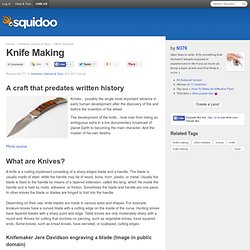
My favourite wood is Ironwood (Erythrophleum chorstachys) but some of the local Acacias are also very hard and make beautiful grips. I make whatever style of knife the customer wishes, but i do not make 'fighting knives' or knives particular to the Japanese or Indonesian cultures except in exceptional circumstances. Customers need to draw around their hand so that i know what size to make the grip - also knives and scabbards for left-handed people are obviously different to right-handers. How to Make Your Own Steel Knifes. Knife making. Jere Davidson engraving a knife Knife Making is the process of manufacturing a knife by any one or a combination of processes: stock removal, forging to shape, welded lamination or investment cast.[1] Typical metals used come from the carbon steel, tool, or stainless steel families.
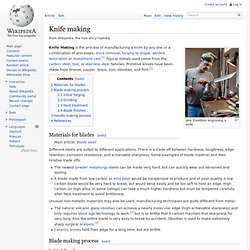
Primitive knives have been made from bronze, copper, brass, iron, obsidian, and flint.[1] Materials for blades[edit] Forge. A blacksmith's coal forge Wooden smithy in Opole, Upper Silesia, Poland Types of forges[edit] Coal/coke/charcoal forge[edit] Standard coal forge Over thousands of years of forging, these devices have evolved in one form or another as the essential features of this type of forge:[citation needed]

Blacksmithing. Blacksmithing is one of the oldest professions in the world and something that has been an integral part of society for a number of years.
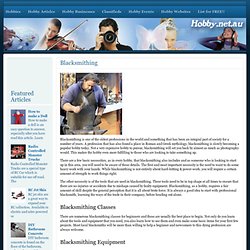
A profession that has also found a place checkout, Knitting Yarn in Roman and Greek mythology, blacksmithing is slowly becoming a popular hobby today. Not a very expensive hobby to pursue, blacksmithing will set you back by almost as much as photography would. This makes the hobby even more fulfilling to those who are looking to take something up. A Gallery of Early Blacksmithing. Now lets talk about condition.

Don't buy an anvil that isn't in one piece. Worn out anvils often appear for sale with such obvious signs of abuse as broken or bent horns and broken heels (often at the hardy hole where tapered tools have been forced in, splitting the metal like wood), or in the case of cast iron anvils with a steel face, a loose or missing face. Check to see that the anvil rings by tapping lightly with a small hammer (ask the owners permission first). With a steel anvil, this should be loud and clear, especially out on the heel. Cast iron anvils with a properly bonded steel face will ring too, but with a different harsher tone.
The ball-bearing bounce test is a useful method of identifying different types of anvil construction. Take a straight edge, small steel ruler and a small engineer's square along and check the face for wear. Measure the hardy hole –avoid anvils with odd-sized holes. Check for repairs done with an arc welder. FAQs about Blacksmithing and Metalworking. Blacksmithing - Appropriate technology: Journey to Forever. With an anvil and a hammer a blacksmith can make everything else he needs.
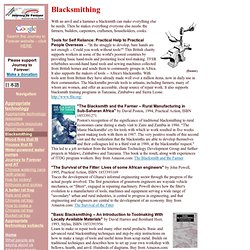
Then he makes everything everyone else needs: the farmers, builders, carpenters, craftsmen, householders, cooks. Tools for Self Reliance: Practical Help to Practical People Overseas -- "In the struggle to develop, bare hands are not enough -- Could you work without tools? " This British charity supports workers in some of the world's poorest countries by providing basic hand-tools and promoting local tool-making. TFSR refurbishes second-hand hand tools and sewing machines collected from British homes and sends them to community groups in Africa.
It also supports the makers of tools -- Africa's blacksmiths. "The Blacksmith and the Farmer -- Rural Manufacturing in Sub-Saharan Africa" by David Poston, 1994, Practical Action, ISBN 1853391271 Poston's recognition of the significance of traditional blacksmithing to rural economies came during a study visit to Zaire and Zambia in 1986.
How to make Knives, Tutorials. Bladesmithing. Blacksmith items_for_sale. Www.artistblacksmith.com Scan the short descriptions of the following blacksmith related tools and products.

For further information on each just click on the links. If you have questions about one of the products just email me, but allow several days for me to get back to you. Please note all prices are subject to HST (13%). Item #1 Just Released! Regular Price $25.00 US Members Price $20.00 US Item#2 75 lb Air Hammer. . $4500.00 CND plus taxes (price subject to change depending on parts prices). Item #3 Gas Forge Construction Video dvd. Please note I have suspended sales of the dvd until the begining of June. Item #4 Gas Forge. Regular Price $510.00 CND Includes HST plus shipping. Item #5 Gas Forge Atmospheric Burner. Pease note this is an unrated propane appliance and as such you use it completely at your own risk! Regular Price $74.00 CND Includes HST plus shipping.
Item #6. Anvilfire.com - Blacksmithing and Metalworkers Reference for Metal Artists. Blacksmith. A blacksmith is a metalsmith who creates objects from wrought iron or steel by forging the metal by using tools to hammer, bend, and cut (cf. whitesmith).
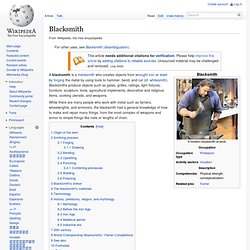
Blacksmiths produce objects such as gates, grilles, railings, light fixtures, furniture, sculpture, tools, agricultural implements, decorative and religious items, cooking utensils, and weapons. While there are many people who work with metal such as farriers, wheelwrights, and armorers, the blacksmith had a general knowledge of how to make and repair many things, from the most complex of weapons and armor to simple things like nails or lengths of chain.
Origin of the term[edit] The term "blacksmith" comes from the activity of "forging" iron or the "black" metal - so named due to the color of the metal resulting from being heated red-hot (a key part of the blacksmithing process). The term "forging" means to shape metal by heating and hammering. Smithing process[edit] Blacksmiths work primarily with wrought iron and steel. Blacksmithing - How To Information. Knife making. How to Build a Forge.